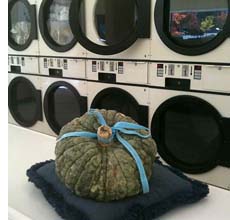Where’s Billy? Raising Squash for Pets or Meat
- By Heidi Lewis
- Reading Time: 2 mins.

You see, Billy is our prize squash. He’s a Marina de Chiogga that we grew in our garden this summer. He should’ve been an eating squash, not a display gourd, but he got tucked under some big leaves and grew to be 20 pounds before we discovered him. Now he’s our family’s pride and joy: he’s been loaned out for harvest displays; trotted down to the beauty parlor where the ladies coo at him; displayed at grandpa’s bridge game where he collects comments such as, “Wow, that’s a looker!” and “Is that the squash that ate Chicago?”

Beautiful winter squash is rolling in from fields East to West and Central to Southwest. Some have more personalities than others. The term “winter” squash is a cultural definition for hard-skinned squash that keeps for months, as opposed to thin-skinned “summer” squash such as zucchini that have to be eaten fresh. Winter squash are an important category of produce that dates back to a time when our survival depended on what could be stored. Cucurbita maxima and C. moschata come in a stunning array of shapes and colors from smooth orbs to some reminiscent of colorful Dale Chihuly sculptures.
Get tips for your office
Be an office hero! One of the world’s oldest cultivated foods, evidence of squash consumption has been found in 10,000-year-old caves and dwellings of ancient Mesoamerica. From there it spread to the rest of the world where each land has cultivated its own unique squash expressions. The bumpy alligator-skinned Marina De Chiogga hails from Italy, the Cinderella coach-looking Musquée de Provence from France, the chestnut-flavored Red Kuri and Kabocha from Japan.
One of the world’s oldest cultivated foods, evidence of squash consumption has been found in 10,000-year-old caves and dwellings of ancient Mesoamerica. From there it spread to the rest of the world where each land has cultivated its own unique squash expressions. The bumpy alligator-skinned Marina De Chiogga hails from Italy, the Cinderella coach-looking Musquée de Provence from France, the chestnut-flavored Red Kuri and Kabocha from Japan.
In North America, the winter squash we are most familiar with are pumpkins, a gift from Native Americans to early settlers. The first pumpkin pie had no crust but was scooped out of a pumpkin filled with apples, cream, and honey that had been set in hot ashes to cook.

“For pottage and puddings and custards and pies
Our pumpkins and parsnips are common supplies
We have pumpkins at morning and pumpkins at noon
If it were not for the pumpkins we should be undoon.”
— Pilgrim verse, circa 1633
The hard shells of winter squash and gourds have been used as scoops, bowls, and even musical instruments. For eating, the skin is too hard to peel: use a knife to cut it halves or quarters, scoop out the seeds, set in the oven in a pan with a little bit of water and cook till soft. Cooked winter squash is so good and so good for you, providing tons of antioxidants, Vitamin A, Vitamin C, potassium, and fiber. It can be used in many delicious combinations, as a puree, soup, fritters, or, of course, in pies.
But sometimes you get attached. Once you give a squash a name, it’s hard to eat ’em. Billy will not turn into a pie but rather will live on our mantelpiece.


